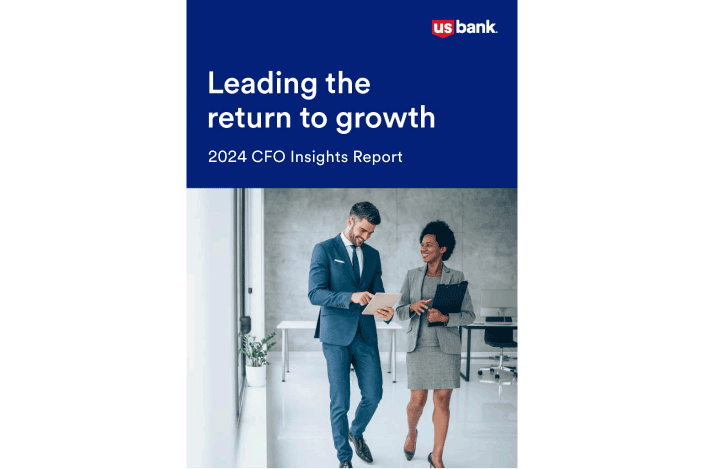What’s driving payments transformation?
The uncertain economic and geopolitical environment coupled with rising instances of cyberattacks and fraud have left finance leaders sharpening their focus on cutting costs and managing risk, according to the fourth annual U.S. Bank CFO Insights Report. The survey of more than 2,000 senior finance leaders nationwide took a close look at the progress and key drivers of their organizations’ payments transformations.
Some 44% say that cutting costs and driving efficiencies in the finance function is a top-three priority, almost double the 23% in 2021. In parallel, a third (33%) pinpoint risk management as a key priority, compared with only 18% in 2021.
Finance leaders have realized that transforming payments can help meet both of these objectives, especially since check fraud has increased 385% since the start of the pandemic.
Risk management has grown in importance to become the top driver of payments transformation. Today, 59% say decreasing risk in payment operations is an important payment transformation initiative in the coming year, up from only 43% two years ago. In parallel, 57% say automating payments is an important initiative, up from 46% in 2022. Improving vendor and customer payment experiences is the third most important driver of payments transformation after being first last year.
More Resources
The continuing rise of digital payments
All of these objectives can be supported with the help of digital payments, which is why companies are adopting new payment types at an impressive rate. About half (51%) currently use instant payments through the RTP® network and the FedNow® Service, which is up from 42% in 2023 and 38% the year before. A staggering eight in 10 expect to use instant payments two years from now.
This growth began to gain momentum following the Federal Reserve’s launch of the FedNow® Service in July 2023, which expanded the reach of instant payments to banks and credit unions that were not already members of the RTP network, which launched in 2017. Instant payments offer immediate settlement and 24/7/365 availability.
Instant payments aren't the only solution for companies looking to expand their digital payment capabilities. Many are seeking options that don't require access to or storage of bank information like transit and routing numbers, common requirements of methods like instant payments or ACH. This is where B2C payment options such as Zelle® and Venmo, which can be linked to a customer account with an email address of cell number, offer a significant advantage. This is why use of these payments options is expected to surge from 46% to 71% two years from now.
Usage of push to debit card (e.g. Visa Direct) will also grow. 40% use this method today, compared with 30% in 2023. Two years from now, 64% expect to use push to debit card. This is in part driven by convenience and availability. Customers only need to provide the number displayed on their card to receive a payment to their account.
“As firms contemplate instant payment rails, they have to think about the ease factor for the end user who is going to be interacting with these payments,” explains Anu Somani, head of global payables and embedded payments at U.S. Bank. “So, if the need for a bank account or ABA routing number is a hurdle to adoption, then it’s important for companies to meet their customers’ preferences through more accessible payment options – such as push to debit card.
Digital payments usage continues to soar
Adoption of digital payments was initially strongest in B2C sectors that were keen to use new payment options to improve customer experiences. Recently, adoption has grown among B2B businesses, who realize that digital payments also reduce risk, create efficiencies and improve experiences for employees.
One way instant payments can do this is by facilitating earned or instant wage access. Earned wage access allows employees to receive wages instantly and securely, without having to wait for payday. Traditionally, these payments would be transferred with ACH and take three days to arrive in the recipient’s account. Instant payments, meanwhile, give employees access to these funds immediately. Such systems enable firms to improve the employee experience and help retain talent in the process.
Instant wage access, which is often called the gig economy payroll, supports the flexible hours of gig workers. It makes sure they get paid immediately for a job they have just completed.
“Growth in instant payments was primarily driven by a need to create great customer experiences,” explains Mike Jorgensen, head of emerging solutions and strategy at U.S. Bank. “But we’re now seeing more back-office applications. There are very interesting use cases in payroll, the gig economy and anywhere where a company needs to move money better and faster.”
This explains why the use of digital payments is growing fastest in industries that rely on gig workers – such as business services, consumer and retail, and hospitality and leisure.
The next frontier: embedding payments
The growing use of digital payments has prompted businesses to consider embedding payments into existing systems. This includes back-office tools used in the finance function, or customer-facing applications. The majority (80%) plan to use fintech systems and platforms to move money two years from now, up from 37% today. And 43% intend to move money through ERP platforms, up from 17% today. This would mark a significant transition from today, where businesses must log into their banking platform to initiate payments.
The ease of embedding payments is one reason why adoption is expected to grow so quickly. Many platforms such as ERPs and Treasury Management Systems (TMS) have pre-built integrations available through multiple banks. Businesses can also use APIs to integrate payment capabilities into their existing systems.
Embedding payments creates seamless and invisible money movement, further improving efficiency, risk management and customer experiences beyond what is achievable through digital payments alone. For some businesses, embedding payments is the only method by which they can utilize instant payments.
There are two primary benefits:
1. Meeting market demand for improved customer experiences
An Uber or Lyft ride provides a good example here. In the past, at the end of a taxi ride, customers had to find the right amount of cash or hope their credit card would work. Uber has eliminated that pain point. Now, passengers get in and out of the car without ever having to think about payment, and drivers get paid immediately on completing a job. It’s all done automatically and at a pre-agreed rate.
Uber aside, customers are increasingly able to pay for goods and services online, in real time, without leaving the website or platform from which they make the purchase. As this becomes more commonplace, they are beginning to demand this payment experience from every business. Embedding payments therefore builds customer loyalty and creates a notable point of differentiation from the competition.
“Consumer demand for a better customer experience is driving a lot of change, especially since COVID-19,” says Jorgensen. “Customers want to pay online, in real time, in an integrated experience that doesn’t require them to jump between sites or different providers. Embedding payments also help businesses differentiate from the competition and be more efficient.”
2. A more efficient and secure finance function
Embedding payments into ERP systems integrates financial transactions onto one platform. Historically, firms have had to send payments through file formats that their bank provides or through their bank’s platform. But today, banks are creating seamless payment experiences where clients can do everything on one platform.
So, employees who spend, say, 95% of their day working in their ERP system can originate secure payments from there rather than via a bank portal. This automates and connects the entire process, reducing the risk of errors that comes from manual data entry and gives the business accurate real-time insights into operations. It also facilitates compliance by ensuring that payment processes align with financial regulations.
“Clients no longer have to take part in a disjointed process,” says Somani. “Instead, the information from the bank flows both ways – from the origination to the balances – and clients are able to continue working in a world that they’re used to.”
Mastering payments transformation
Payments transformation can seem like a daunting prospect. It doesn’t need to be. The emergence of embedded payments makes it easier for businesses to make digital payments within their existing systems.
That said, business leaders need to remember that transforming payments is a long journey that brings short- and long-term benefits. “The clients that transform payments successfully are able to articulate a stated goal, whether that be removing paper from back-office processes or improving net promoter scores,” explains Somani. “A willingness to change the status quo is also vital.”
The CFO must be invested in driving payments transformation from the start. Embedding payments requires a change in systems and process across multiple departments, which requires a C-level mandate to successfully execute – it’s not something the procurement team or accounts payable can achieve on their own. So, CFOs must actively lead decision-making throughout the process.
Infographic: See what’s driving finance leaders to transform payments.
Get even more insights around the accelerating adoption of digital payments and embedded payments among some of the nation’s leading organizations.

Read the full 2024 CFO Insights Report.
The CFO Insights Report is filled with information that extends beyond the world of payments. Discover what’s most important to finance leaders as they seek to guide their organizations to success amid economic uncertainty, geopolitical tensions and the continuing emergence of digital technologies.
More insights from our research

California report
What are California’s finance leaders focused on?

Economy
How are finance leaders viewing the economy?

Digital Transformation
Leaders seek accelerated digital transformation.

Healthcare Report

